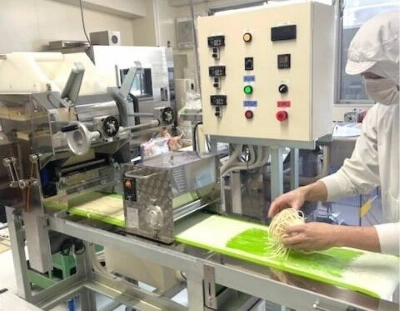From the Byzantine times in the 9th century, Venice was a strategic trading center straddling Europe and the East. Venetian merchants traded wool and silk textiles for spices, grains and other commodities from Asia, making the city — and the Venetian Republic of which it was the center — one of the most powerful and prosperous regions in Europe until the start of its decline in the 15th century.
The wealth and success of the republic fueled developments in Venetian art, architecture, fashion and literature, many examples of which have been brought together for the Edo Tokyo Museum's current exhibition.
"A Portrait of Venice" opens with a large wooden sculpture of a winged lion, the symbol of the city's patron, the apostle St. Mark, whose name is honored in various place names across the city, including the Piazza San Marco, the important square that served as the locus of the city's religious, economic and political power. The winged lion is also depicted in a number of paintings, one of which has it with its front legs on land and hind legs in the water, indicating the significance of Venice's location and waterways to its prosperity.
As well as fleets of merchant ships, Venice also had the most powerful navy in Europe. When the Ottoman Empire threatened Europe in the 16th century, the Venetian navy joined those of other papal states — Italian provinces and Spain — to form the Holy League, which defeated and halted the Ottomoan Turks' advance into Europe.
The pivotal 1571 Battle of Lepanto was depicted by Andre Vicentino in a famous 1603 oil painting, housed at the Doge's Palace in Venice, and an earlier version of this work has been brought to Tokyo for this exhibition. Dated somewhere between the battle itself and 1600, it shows the scale of the event, the focus being on the ships, flags and the glory of victory rather than any messy one-on-one confrontations.
The importance of the city's maritime culture is further emphasized in the displays by the inclusion of a telescope, sundial, compass, a large-scale model ship, some nautical maps and a huge globe from the late 17th century. The vast range of artifacts — later the exhibition introduces Venetian costumes, crockery, chandeliers and more — along with numerous paintings, makes "Portrait of Venice" less an art exhibition than a whistle-stop tour of the city and an introduction to various aspects of its cultural, political and economic history.
The civic and political aspects are represented through a selection of coins and various antiquities, including portraits of fleet commanders, attorneys and other public figures, including several doges (high-ranking officials), one painted by Gentile Bellini and another by Vittore Carpaccio. The latter, from 1505-10, is of the Doge Leonardo Loredan and shows Carpaccio's skilled use of texture and color through the detailed brocade and golden orange fabric of the doge's cloak.
Portraying the Ducal Palace, with members of the city's governing council in attendance, is a 19th-century painting, attributed to, simply, an unknown Venetian citizen. The real star of this picture is the magnificent room itself, its length of 50 meters rendered in deep perspective. Its ornate high ceiling stands firm, even without any supporting columns, as it towers over rows of bewigged figures vanishing into the distance.
A number of pictures depict processions or bull hunts at the Piazza San Marco. A late 17th-century painting details a procession that is still part of the annual Festa del Redentore, instigated in the late-16th century to celebrate the city's recovery from an outbreak of plague. The picture shows the narrow walkways and bridges thronged with crowds coming out to see the priests in the procession.
One room of the exhibition is dominated by the paintings of the city's celebrated 19th-century artist Pietro Longhi, or works carried out by his studio or followers. These include portrayals of rich Venetian citizens that contrast scenes of public life, such as a concert and a dance, with private moments, such as having a haircut, an illicit round of gambling and the even more illicit whispering of words of love to a woman.
The exhibition ends with a section representing the kind of private painting gallery any rich and successful Venetian would have had at home. With works by Carpaccio, Tintoretto, as well as some lesser known names, one of the highlights here is a pair of Grande Canal scenes from Canaletto's studio — giving views from either end of the canal. By the time these were painted in the 18th century, Venice's glory days were over, surpassed by the might of Portugal and other European powers. Soon after, the Venetian Republic lost its independence in its surrender to Napoleon Bonaparte, but it left behind a wealth of culture for posterity.
"A Portrait of Venice" at the Edo Tokyo Museum runs till Dec. 11; admission ¥1,400; open 9:30 a.m.-5:30 p.m. (Sat. till 7:30 p.m.), closed Mon. For more information, visit www.edo-tokyo-museum.or.jp.

















With your current subscription plan you can comment on stories. However, before writing your first comment, please create a display name in the Profile section of your subscriber account page.